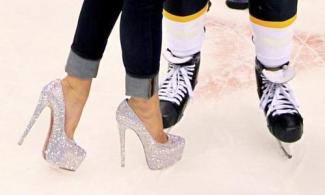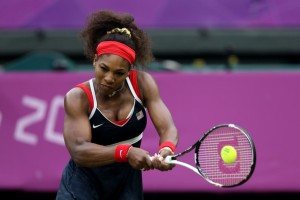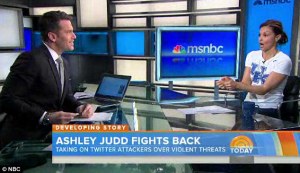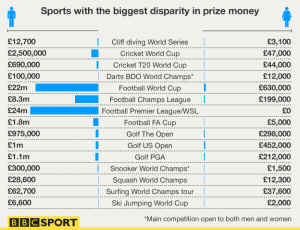
At a very early age boys are taught that they should be “masculine.” In order fit the hegemonic masculine image they must exhibit traits such as aggression, competitiveness, and strength. Gender stereotypes also reinforce the notion that boys should play and watch sports. For example, many boys are socialized at a young age by playing hockey with ‘mini sticks’, while girls are encouraged to play non-aggressive games such as ‘house’. As children grow up, these stereotypes continue to be reinforced. The propagation of these stereotypes work to reinforce the large gap in gender equality within the sporting industry.
Males have always dominated the fan base in sports and because of this there is a generalization that men are more knowledgeable and committed to sports than women. This male privilege has helped foster the creation of the term “Puck Bunny.” In 2004, the term “Puck Bunny” was added to the Canadian Oxford Dictionary (Albrechtson, 2009). It is a word used in hockey that objectifies and stereotypes women; Puck Bunny refers to “a woman who goes to hockey games for the sole purpose of ‘scoring’ with one of the players afterwards, a hockey whore.” (Avery, 2009) This generalization that men have more knowledge of and commitment to sports and the concept of a Puck Bunny both work to oppress women in the sports industry. This has prevented women from being taken seriously or treated with respect within certain context of the sports world.
Women may have a difficult time in the male socialized sports world and this is exemplified through the story of Ashley Judd. Often, if one speaks out in opposition to the opinions of our patriarchal society, they become shunned. Judd’s story sheds light on this patriarchal and capitalistic control that is insidious within the entire sports industry. Judd, a 42-year-old actress and advocate for social justice cheered for the University of Kentucky’s basketball team during the SEC Tournament Finals on Sunday, March 15th, 2015. In the midst of the excitement, Judd tweeted against the opposing team, “playing dirty & can kiss my team’s free throw making a—.” (Time, 2015) In response to Judd’s tweet, twitter followers sent her explicit and threatening tweets. The content of these tweets objectified, insulted, sexualized, and dehumanized her. Judd explained to UsMagazine that the amount of gender based violence she experienced was “absolutely extraordinary” and resulted in her filing police reports (Lee, 2015). Through Judd’s story, we can understand that the male-dominated, capitalistic sports industry further increases the oppression of women and perpetuates negative stereotypes.
For years, professional female athletes have not been given the same opportunities that men have been given. The best example of this is the National Hockey League (NHL) where only men are allowed to play. Although there is a Women’s Canadian Hockey League (WCHL), it is far less supported or acknowledged in comparison to the NHL. In Mett Larkin’s article, The fight to sell women’s hockey: Can the CWHL become the WNBA, he explains that the CWHL has sponsors such as Scotiabank, Bauer, and Molson, yet these companies do not provide the significant financial aid that the league needs in order to break into a new popularity stratosphere. However, Sportsnet has made a four-year deal to broadcast three games during the Clarkson Cup tournament in March as well as the December’s CWHL All-Star Game (The Hockey News, 2015). Although these are positive gains for women, our patriarchal society still teaches boys and girls at an early age that is it male athletes who deserve the encouragement and high levels of legitimacy. Male athletes are therefore perceived as more profitable and have the best opportunities for success.
Not only does this gender inequality make it more difficult for women to play professional sports, but there are also many situations within the sports world where women are downgraded and hyper-sexualized. Serena Williams is the first black woman to be ranked No. 1 in women’s singles tennis (Gaston, 2014). Despite her achievements, she experiences body shaming, racism and dehumanization. Williams experiences exemplifies the white supremacy that controls the sporting industry. In one example, Sid Rosenberg, a radio host on 640 Sports referred to Williams as an “animal”. In other instances, remarks made about Williams include suggestions that black women aren’t “real women” and that they are “indistinguishable” from men due to their ‘dangerous’ black bodies (Desmond-Harris, 2015). The horrible backlash that Williams receives as a woman of colour illustrates how society is still affected by the long history of colonialism and slavery. As explored in tutorial during Week 6, during the Trans-Atlantic Slave Trade it was common for black women to be raped and victimized because they were viewed as property, free laborers and not civilized humans (Maria-Teresa, 2015). Similar to Laverne Cox’s video on the violence trans women of colour experience, it is apparent that racial inequality is still prevalent throughout society.
Both Ashley Judd and Serena Williams have been victims to the unfair treatment that women are subjected to within the sports world; however, Judd is a white woman and because of this she has a privileged positionality. This positionality allows her to have a voice in speaking out and raising awareness of the oppression women experience in the sports world. Judd does so by retweeting everyone’s tweets that related to her. In this act of defiance, Judd resists the patriarchal system and the misogyny that surrounds the sports industry. Although raising awareness is important in eradicating injustices, her protest stems from her experience as a white women and does not include mention of the oppression that black women experience in the sports world. This situation highlights the complexity around speaking out and raises the question: can one activist speak for all women?
In Danyel Haughton’s special lecture on Seeing is Not Believing, she emphasizes the importance of Black twitter and the use of the hashtag #Blacklivesmatter. Through the use of social media, the black community is able to speak up about the systematic and purposeful targeting they experience (Haughton, 2015). Twitter is a powerful tool, one that is utilized by both Judd and black communities around the world.Hopefully, the continual use of media activism will result in more support, acknowledgment and ultimately the eradication of the oppression women face in the sports industry.
Work Cited
Albrechtson, Meagan. “She Got Game.” Toronto Sun. Canoe Sun Media, 6 June 2009. Web. 5 Apr. 2015. Retrieved from <http://www.torontosun.com/life/2009/06/06/9697201-sun.html>.
Avery, Martin. The Devils Wear Bauer (Not Prada). Lulu.com, 2009. 56. Print.
Charlotte, Alter. “Ashley Judd Speaks Out About Twitter Abuse and Rape.” Time. Time, 19 Mar. 2015. Web. 5 Apr. 2015. Retrieved from <http://time.com/3750788/ashley-judd-speaks-out-about-twitter-abuse-and-rape/>.
Desmond- Harris, Jenee. “Beyond Indian Wells: Serena Williams Has Been Consistently Disrespected for Her Entire Career.” Vox. Vox Media, 11 Mar. 2015. Web. 5 Apr. 2015. Retrieved from <http://www.vox.com/2015/3/11/8189679/serena-williams-indian-wells-racism>.
Gaston, Corinne. “Serena and Venus Williams Battle More Body-Shaming.” Ms Magazine Blog. 23 Oct. 2014. Web. 5 Apr. 2015. Retrieved from <http://msmagazine.com/blog/2014/10/23/serena-and-venus-williams-battle-more-body-shaming/>.
Haughton. “Seeing Is Not Believing.” GNDS 125 Lecture . Queen’s University. Bioscience Complex, Kingston. 2 Mar. 2015. Lecture.
Larkin, Matt. “The Fight to Sell Women’s Hockey: Can the CWHL Become the WNBA?”The Hockey News. Transcontinental Media G.P., 5 Jan. 2015. Web. 5 Apr. 2015. Retrieved from <http://www.thehockeynews.com/blog/the-fight-to-sell-womens-hockey-can-the-cwhl-become-the-wnba/>.
Lee, Esther. Ashley Judd Pressing Charges Against Twitter Trolls for Vulgar Tweets: They Need to “Take Personal Responsibility” US WEEKLY, 17 Mar. 2015. Web. 5 Apr. 2015. Retrieved from <http://www.usmagazine.com/celebrity-news/news/ashley-judd-pressing-charges-against-twitter-trolls-for-vulgar-tweets-2015173>.
Matani, Maria-Teresa. “Colonialism and Slavery.” Tutorial . , Kingston . 12 Feb. 2015. Class Lecture.



Having written about Ashley Judd’s experience myself, I appreciate how all-encompassing your blog is. Sports are inherently a site for gender inequality and oppression, and I like how you gave the example of boys being handed hockey sticks as children, while girls are encouraged to play “house,” further reinforcing that women should ultimately remain in the private sphere and that a domestic life is the one they should seek out and aspire to have. Relegating girls to the private sphere is done at such a young age, adding another barrier to their participation in institutions such as sports.
The National Hockey League (NHL), and hockey overall, is a great example of the inequality of opportunity that women face in the sports industry, especially in the Canadian context. One might consider the two Olympic divisions (men’s and women’s) when realizing this; with both Canadian teams frequently making the finals and receiving gold or silver medals – with the women’s team receiving more gold medals recently than the men’s team – one would imagine both teams to be heralded as “Canadian heroes,” as hockey continues to be a part of the nationalist fabric that our government boasts. However, the women’s final is not held in nearly the same regard as men’s. Considering that men and women participate in each Olympic sport, why do you think such a serious disparity occurs at this level?
Your discussion of race and Serena Williams is also an important one. One might notice that black or white bodies are more common in some sports than others, and tennis is an example of this. The practice of hypersexualizing women’s bodies is synonymous with the sports industry, but it is especially disappointing to see that women like Williams are not recognized for their accomplishments, but simply for the gender and their bodies. Why do you think that this horrible “practice” does not extend to black men athletes, such as PK Subban who plays for the Montreal Canadiens?
The points regarding twitter and #blacklivesmatter were also interesting. I would be interested to understand whether or not such social media platforms are ultimately beneficial, or more often perpetuate patriarchal norms and promote harmful prejudices. Why couldn’t women like Serena Williams turn to twitter to articulate their views, and seek out support? Has social media helped to perpetuate the negative stereotypes and patriarchal, hegemonic masculine agenda behind the sports industry?
LikeLike
You touched on some really great points in this post. I really appreciated that you talked about Ashely Judd’s positionality, and the reality that it is easier for an upper-class white woman to have a voice on this stage than perhaps a black woman. Though implicit in your message, I do think that there is merit in explicitly stating the cis-privilege when it comes to activism on a high profile public forum such as twitter. If a trans woman were to go on twitter and speak out about the lack of (or absence of) trans representation in the sports industry, not only would the message not span as far, it would receive much more backlash than Ashley Judd received. This is not to undermine Judd’s efforts, however it is extremely important to know which voices are speaking so that we know which voices are still not being heard.
Though less relevant to your post, I had a thought while reading our blog. We chat a lot about white supremacy in the context of black citizens of the state as though it is a dichotomy of sorts. However, also under-represented but less discussed populations are: East-Asian, Middle-Eastern, Southeast Asian, and Latino populations. These identities are rarely discussed in the discourse of white privilege and what it means for minority racial ethnic populations. For example, in keeping with the discussion of the sports industry, a couple of years ago when Jeremy Lin was all that anyone could talk about when it came to the NBA, his presence in the NBA was extremely tokenized as an Asian-American player. Though his merit was undeniable, I would be extremely doubtful that there were no alternative agendas on the part of NBA marketing to push his story so far. We often talk about the hypersexualization of Black females in the media, but this is also true of Asian females. These sexualized and tokenized Asian women are often seen on cheerleading teams, but usually there is just one, perhaps to strike some kind of “balance”. It is interesting to think about!
LikeLike
I definitely agree with you that gender role stereotypes are very damaging to all of society. Often when people talk about feminism, they envision that it benefits only women. Hegemonic masculinities are such an important point of study, as it creates an idealised type of male, one that is often aggressive and has alpha status.
What I still find so bizarre, is that male football payers earn ridiculous amounts of money, and female sports are hardly recognized at all. Not only this, but women who are into sports are often seen as not quite fully female and are often objectified, insulted and sexualized.
Furthering the bias, which you touch on is the intersections between racial and gendered discrimination in the sports word, you mention this is because we live in a patriarchal white supremacist society. Which is unfortunately true, social media is a good way to combat some aspects of this, however I think we need to go deeper into the depths of our society and work together to end racial and gendered discrimination
LikeLike